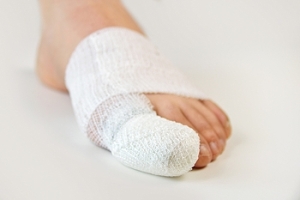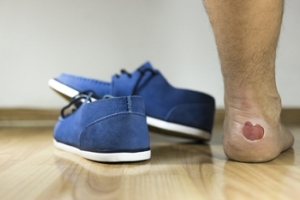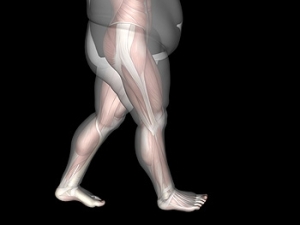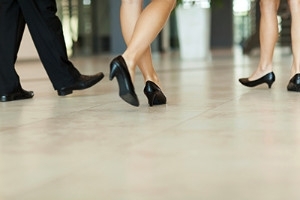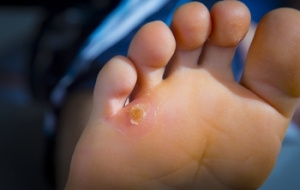Super User
How Do Broken Toes Occur?
 Symptoms that are indicative of a broken toe often include severe pain, swelling, and bruising. It can become fractured as a result of a heavy object that has fallen on it, or if it is stubbed against a piece of furniture. The most common toes to break are the big and pinky toes, and this may happen because they are the least protected. If you feel you have broken your toe, it is helpful to have a proper diagnosis performed. This typically consists of having an X-ray taken, which is generally the most effective method in determining if a fracture has occurred. Many patients find relief in taping the affected toe to the one next to it. This is referred to as “buddy taping”, and may help to stabilize the toe as the healing process takes place. If you have broken your toe, please consult with a podiatrist who can guide you toward the correct treatment.
Symptoms that are indicative of a broken toe often include severe pain, swelling, and bruising. It can become fractured as a result of a heavy object that has fallen on it, or if it is stubbed against a piece of furniture. The most common toes to break are the big and pinky toes, and this may happen because they are the least protected. If you feel you have broken your toe, it is helpful to have a proper diagnosis performed. This typically consists of having an X-ray taken, which is generally the most effective method in determining if a fracture has occurred. Many patients find relief in taping the affected toe to the one next to it. This is referred to as “buddy taping”, and may help to stabilize the toe as the healing process takes place. If you have broken your toe, please consult with a podiatrist who can guide you toward the correct treatment.
Broken toes may cause a lot of pain and should be treated as soon as possible. If you have any concerns about your feet, contact one of our podiatrists from Carolina Foot & Ankle. Our doctors will treat your foot and ankle needs.
What Is a Broken Toe?
A broken toe occurs when one or more of the toe bones of the foot are broken after an injury. Injuries such as stubbing your toe or dropping a heavy object on it may cause a toe fracture.
Symptoms of a Broken Toe
- Swelling
- Pain (with/without wearing shoes)
- Stiffness
- Nail Injury
Although the injured toe should be monitored daily, it is especially important to have a podiatrist look at your toe if you have severe symptoms. Some of these symptoms include worsening or new pain that is not relieved with medication, sores, redness, or open wounds near the toe.
If you have any questions, please feel free to contact one of our offices located in Huntersville Office | 16419 Northcross Dr Suite A, Huntersville, NC 28078; Mooresvillle Office | 206 Joe Knox Avenue Suite D, Mooresville, NC 28117; and Mountain Island | 10310 Couloak Drive Suite 200, Charlotte, NC 28216 . We offer the newest diagnostic and treatment technologies for all your foot care needs.
What to Know About a Broken Toe
The forefoot is composed of five metatarsal bones and fourteen phalanges. Each toe has three phalanges except for the big toe which only has two. Our toes play an essential role to the walking process, which is why a broken toe could seriously disrupt one’s ability to move around. Toe fractures are common and can be very painful. Fortunately, these injuries rarely require surgery and usually heal with rest and a change in activity.
Broken toes typically result from a traumatic event such as falling, stubbing the toe, or dropping something on the toe. Traumatic toe fractures may be categorized as either minor or severe fractures. At times, one may hear a “pop” or “crack” sound when the bone breaks. Common symptoms of a traumatic toe fracture include pain, throbbing, bruising, swelling, and redness.
Another type of toe fractures is a stress fracture. These injuries usually appear in the form of small hairline breaks on the bone. Stress fractures develop after repetitive activity instead of a single injury. Stress fractures occur when the muscles in the bone become too weak to absorb impact. Consequently, the toe bone becomes vulnerable to any pressure and impact it endures. Symptoms for a stress fracture in the toe include swelling without bruising, tenderness to the touch, pain that goes away with rest, and pain after walking or running.
If you suspect that you have a broken toe, you should make an appointment with your podiatrist. He or she will likely diagnose you by performing a physical exam and an X-ray. Treatment for a broken toe may include the R.I.C.E. method, buddy taping, surgery, or antibiotics. The R.I.C.E. method (Rest, Ice, Compression, and Elevation) is a common treatment method for many injuries because it decreases pain. Buddy tapping involves wrapping the injured toe next to an adjacent toe to keep it supported and protected. These two methods have proven to be effective in the healing process for toe fractures. The estimated healing time for a broken toe is approximately four to six weeks. If the injury becomes infected or requires surgery, the estimated healing time may take eight weeks or more.
Excess Friction May Cause Blisters
 Many patients will experience blisters on the feet as a result of friction. These can form on the back of the foot from wearing shoes and socks that do not fit correctly, which may cause difficulty in walking. When the skin in the affected area becomes damaged, the body’s natural response will be to form a small bubble over it. This is filled with liquid that will protect the area that has become raw. Additionally, there may be other reasons for blisters to form. These can include allergic reactions to insect bites, frostbite, or severe burns, and medical conditions such as herpes or eczema. As new skin grows, the majority of blisters will drain and heal on their own. If your blister has become infected, or is not healing in a timely fashion, it is suggested that you consult with a podiatrist.
Many patients will experience blisters on the feet as a result of friction. These can form on the back of the foot from wearing shoes and socks that do not fit correctly, which may cause difficulty in walking. When the skin in the affected area becomes damaged, the body’s natural response will be to form a small bubble over it. This is filled with liquid that will protect the area that has become raw. Additionally, there may be other reasons for blisters to form. These can include allergic reactions to insect bites, frostbite, or severe burns, and medical conditions such as herpes or eczema. As new skin grows, the majority of blisters will drain and heal on their own. If your blister has become infected, or is not healing in a timely fashion, it is suggested that you consult with a podiatrist.
Blisters are prone to making everyday activities extremely uncomfortable. If your feet are hurting, contact one of our podiatrists of Carolina Foot & Ankle. Our doctors can provide the care you need to keep you pain-free and on your feet.
Foot Blisters
Foot blisters develop as a result of constantly wearing tight or ill-fitting footwear. This happens due to the constant rubbing from the shoe, which can often lead to pain.
What Are Foot Blisters?
A foot blister is a small fluid-filled pocket that forms on the upper-most layer of the skin. Blisters are filled with clear fluid and can lead to blood drainage or pus if the area becomes infected.
How Do Blisters Form?
Blisters on the feet are often the result of constant friction of skin and material, usually by shoe rubbing. Walking in sandals, boots, or shoes that don’t fit properly for long periods of time can result in a blister. Having consistent foot moisture and humidity can easily lead to blister formation.
Prevention & Treatment
It is important to properly care for the affected area in order to prevent infection and ease the pain. Do not lance the blister and use a Band-Aid to provide pain relief. Also, be sure to keep your feet dry and wear proper fitting shoes. If you see blood or pus in a blister, seek assistance from a podiatrist.
If you have any questions, please feel free to contact one of our offices located in Huntersville Office | 16419 Northcross Dr Suite A, Huntersville, NC 28078; Mooresvillle Office | 206 Joe Knox Avenue Suite D, Mooresville, NC 28117; and Mountain Island | 10310 Couloak Drive Suite 200, Charlotte, NC 28216 . We offer the newest diagnostic and treatment technologies for all your foot care needs.
Blisters
Blisters are pockets of fluid that occur under the top layer of your skin. These fluid pockets are usually filled with pus, blood, or serum. Blisters may itch or hurt and can appear as a single bubble or in clusters.
The most common types of blisters are friction blisters. This type of blister may be caused by wearing shoes that are too tight. Friction blisters can also occur on the hands. A change in temperature may also cause blisters on the feet. In the freezing air, frostbite on your toes can lead to blisters, as well as sunburn from hot weather.
The best way to treat a blister is to keep it clean and dry. Most blisters will get better on their own. Once the skin absorbs the fluid within the blister, it will flatten and eventually peel off. You should avoid popping your blister unless you podiatrist does it for you. Additional treatment options include applying an ice pack to the blister or using over-the-counter blister bandages to cover the affected area.
If your blister becomes discolored, inflamed, or worsens it is advised that you speak to your podiatrist. Blisters that are yellow, green, or purple may be infected and require immediate medical attention. Blisters that are abnormally colored may be a sign of a more serious underlying health condition such as herpes.
Potential Foot Damage as a Result of Obesity
 Research has indicated patients who are obese may suffer from tendon damage in the feet and ankles. This may precede serious foot conditions. People who are obese may choose to wear shoes that have little or no support because they are easy to slip into, but these types of shoes can cause severe arch problems, and can lead to possible bone damage. Additionally, being excessively overweight can damage the plantar fascia, which is a band of tissue that is located on the bottom of the foot. This connects the heel to the toes, and plantar fasciitis may develop if it becomes inflamed. Children may endure structural changes to the feet if they are overweight, and this may change the way they walk. If you have concerns about how obesity can affect the feet, it is strongly suggested that you speak to a podiatrist who can answer any questions or concerns you may have.
Research has indicated patients who are obese may suffer from tendon damage in the feet and ankles. This may precede serious foot conditions. People who are obese may choose to wear shoes that have little or no support because they are easy to slip into, but these types of shoes can cause severe arch problems, and can lead to possible bone damage. Additionally, being excessively overweight can damage the plantar fascia, which is a band of tissue that is located on the bottom of the foot. This connects the heel to the toes, and plantar fasciitis may develop if it becomes inflamed. Children may endure structural changes to the feet if they are overweight, and this may change the way they walk. If you have concerns about how obesity can affect the feet, it is strongly suggested that you speak to a podiatrist who can answer any questions or concerns you may have.
The more you weigh, the harder your feet must work to support your body. If you’re an obese individual and are concerned about your feet, contact one of our podiatrists from Carolina Foot & Ankle. Our doctors can provide the care you need to keep you pain-free and on your feet.
Obesity and Your Feet
People who are overweight are putting more pressure on their ankles, knees, and hips as well as their feet. This unfortunately can lead to variety of different issues.
Problems & Complications Stemming from Obesity
- When the body is overweight, it tries to compensate by changing the way that it moves. An obese person may lean forward and put extra weight on the wrong part of the foot. This puts unnecessary stress on the feet.
- Obese people are also more likely to develop type II diabetes which is a condition that causes a lot of foot problems. People with diabetes often don’t feel the cuts and sores that they may have on their feet, which can lead to more complicated and severe issues.
- Plantar fasciitis is another foot condition that can be caused by obesity. Plantar fasciitis is an inflammation of the tissue along the bottom of the foot, which causes pain and stiffness while walking and climbing stairs.
If you have any questions, please feel free to contact one of our offices located in Huntersville Office | 16419 Northcross Dr Suite A, Huntersville, NC 28078; Mooresvillle Office | 206 Joe Knox Avenue Suite D, Mooresville, NC 28117; and Mountain Island | 10310 Couloak Drive Suite 200, Charlotte, NC 28216 . We offer the newest diagnostic and treatment technologies for all your foot care needs.
How Obesity Affects Your Feet
Gaining weight can happen suddenly and at any time. Usually you won’t notice the extra weight until your feet start hurting at the end of the day. This happens as your feet begin adjusting to carrying more weight. Foot swelling and pain are two of the biggest side effects of having gained weight.
Many foot-related problems can occur even after just putting on a few pounds. This includes the body ‘compensating’ by changing the way it moves. You may find yourself putting extra weight on the wrong parts of your feet and even leaning forward a bit. Your feet were designed to carry a healthy, normal body weight. Extra weight places undue stress on them.
Being overweight often causes the development of Type-2 diabetes, causing leg and foot pain. Older people who do not attempt to control their condition can even lose sensation and feeling in their legs and feet. This can lead to the development of small sores that can lead to serious infection.
Extra stress placed on the joints, tendons and muscles in the feet as a result of extra body weight may also cause heel spurs, or plantar fasciitis. Plantar fasciitis is an inflammation of the foot tissue, causing stiffness and pain when walking and climbing stairs. This can usually be relieved by foot stretches and custom made orthotic shoe-inserts.
Problems in the feet triggered by obesity can be treated by paying special attention to footwear. Proper support shoes that allow for good circulation, especially in the arch and ankle, are vital. A podiatrist can help you find what sort of shoe is most suitable for your feet. They can also measure you for special orthotics if necessary.
It could also be high time to start losing weight in order to treat and prevent diabetes as well as other life threatening diseases. Some methods include yoga and water aerobics, which benefit your entire body without placing stress on your feet. Don’t risk losing your feet by losing interest in them. Take care of your feet and your body, as they deserve the very best.
Choosing Shoes For The Work Day
 Many people experience uncomfortable foot conditions as a result from standing for long periods of time to complete their work day. Research has shown the importance of wearing proper shoes while working, and this may be beneficial in providing moderate relief. The feet, and overall body, will feel more comfortable when there is adequate room in the shoes for the toes to move freely in. It is helpful to choose shoes that have enough cushioning, and shoes that have a wide heel to provide ankle stability. If the feet become swollen during the work day, it is recommended to elevate them during designated breaks. If you would like additional information about how to protect your feet while working, please consult with a podiatrist.
Many people experience uncomfortable foot conditions as a result from standing for long periods of time to complete their work day. Research has shown the importance of wearing proper shoes while working, and this may be beneficial in providing moderate relief. The feet, and overall body, will feel more comfortable when there is adequate room in the shoes for the toes to move freely in. It is helpful to choose shoes that have enough cushioning, and shoes that have a wide heel to provide ankle stability. If the feet become swollen during the work day, it is recommended to elevate them during designated breaks. If you would like additional information about how to protect your feet while working, please consult with a podiatrist.
While working on the feet, it is important to take the proper care of them. For more information about working on your feet, contact one of our podiatrists from Carolina Foot & Ankle. Our doctors will treat your foot and ankle needs.
Working on Your Feet
Standing on your feet for long periods of time can cause stress and pain in your feet. Your whole body may experience change in terms of posture, back pain, bunions, callouses and or plantar warts. There are ways to avoid these conditions with proper foot care, smart choices and correct posture.
Positive Changes
Negative heeled shoe – Choosing this shoe type places the heel slightly lower than the ball of the foot. These are great for overall foot health. Find shoes that fit you correctly.
Go barefoot – Our feet were not designed to be enclosed for all hours of the day. Try to periodically expose your feet to air.
Eliminate Pain
Foot Exercises – Performing simple exercises, incorporating yoga and doing stretches are beneficial. This will allow increased blood flow to the area and muscles of the foot.
Achilles tendon – Stretching the foot out flat on the floor will relax the calf muscles and tendon. These exercises can be performed almost anywhere. Make sure you add these exercises to your daily regimen.
With a little bit of this information and knowing more about foot health, you will notice changes. Foot stretches and proper footwear will help with pain and prevent further issues.
If you have any questions please feel free to contact one of our offices located in Huntersville Office | 16419 Northcross Dr Suite A, Huntersville, NC 28078; Mooresvillle Office | 206 Joe Knox Avenue Suite D, Mooresville, NC 28117; and Mountain Island | 10310 Couloak Drive Suite 200, Charlotte, NC 28216 . We offer the newest diagnostic and treatment technologies for all your foot and ankle needs.
How to Handle a Long Work Day on Your Feet
In 2014, the American Podiatric Medical Association surveyed 1,000 American adults and found that half of all respondents lived with foot pain. Fortunately, there are ways to avoid foot problems such as following a daily footcare routine and wearing proper footwear at work.
If you have a job that requires you to be on your feet, it is best that you do not wear flat sole shoes. Your heel should be slightly elevated (less than 2 inches, but at least ¼-inch) if you are going to be standing for a prolonged period. You should also make sure that the shoes you wear are not too small. Tight shoes may cut off circulation to your feet, which will result in pain and blisters. It is always best to purchase fitted shoes later in the day, because the feet tend to swell as the day progresses. It may also be helpful to buy shoes a half size larger if you plan on wearing custom orthotics or arch supports.
Your muscles may become stiff when you are constantly standing up. It is important to take breaks every hour to stretch and relax. One tip is to perform calf raises, because this exercise will help improve your circulation. To perform this stretch, you first need to stand on the edge of a step with your abdominal muscles pulled inward. You then need to grip the step with the balls of your feet with your heels hanging over the edge. Next, try to raise your heels above the step by a few inches while standing on your tiptoes; hold this pose for a second. You should then lower your heels back even to the platform. These calf raises should be done ten times for full effectiveness.
You should also take care of your feet while you are at home. One of the best ways to prepare your feet for a long day of work is to soak them in ice water. Doing so for 20 minutes will help fight the swelling and inflammation that results from being on your feet at work.
Nevertheless, if you are experiencing pain in your feet, you should seek help from your podiatrist. Your doctor will help treat any ailments you may have in addition to helping you prevent any other ailments from developing in the future.
What Causes Corns?
 Corns develop on the feet as a result of increased friction that comes from wearing shoes that are too tight. Additionally, they may develop from standing or walking for the majority of the day, and this may cause the toes to rub together. Corns are most likely to form on the top of the toes or on the bottom of the feet. Some patients will notice a corn on the inside of their toes, and this can form from excessive moisture from consistently wearing socks. Mild relief can be found if corn pads are worn. These can be effective in protecting the area of the foot from the part of the shoe that caused the friction. There are methods that can be implemented which may help to prevent corns from developing. These can include wearing shoes and socks that fit properly, and trimming the toenails frequently. If you are afflicted with a corn, please consult with a podiatrist who can guide you towards the proper treatment.
Corns develop on the feet as a result of increased friction that comes from wearing shoes that are too tight. Additionally, they may develop from standing or walking for the majority of the day, and this may cause the toes to rub together. Corns are most likely to form on the top of the toes or on the bottom of the feet. Some patients will notice a corn on the inside of their toes, and this can form from excessive moisture from consistently wearing socks. Mild relief can be found if corn pads are worn. These can be effective in protecting the area of the foot from the part of the shoe that caused the friction. There are methods that can be implemented which may help to prevent corns from developing. These can include wearing shoes and socks that fit properly, and trimming the toenails frequently. If you are afflicted with a corn, please consult with a podiatrist who can guide you towards the proper treatment.
Corns can make walking very painful and should be treated immediately. If you have questions regarding your feet and ankles, contact one of our podiatrists of Carolina Foot & Ankle. Our doctors will treat your foot and ankle needs.
Corns: What Are They? And How Do You Get Rid of Them?
Corns are thickened areas on the skin that can become painful. They are caused by excessive pressure and friction on the skin. Corns press into the deeper layers of the skin and are usually round in shape.
Ways to Prevent Corns
There are many ways to get rid of painful corns such as:
- Wearing properly fitting shoes that have been measured by a professional
- Wearing shoes that are not sharply pointed or have high heels
- Wearing only shoes that offer support
Treating Corns
Although most corns slowly disappear when the friction or pressure stops, this isn’t always the case. Consult with your podiatrist to determine the best treatment option for your case of corns.
If you have any questions please feel free to contact one of our offices located in Huntersville Office | 16419 Northcross Dr Suite A, Huntersville, NC 28078; Mooresvillle Office | 206 Joe Knox Avenue Suite D, Mooresville, NC 28117; and Mountain Island | 10310 Couloak Drive Suite 200, Charlotte, NC 28216 . We offer the newest diagnostic and treatment technologies for all your foot and ankle needs.


